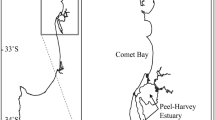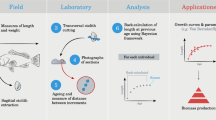Abstract
Otolith increment age estimates for a deepwater species, Allocyttus verrucosus, were validated by comparison with the results from 210Pb:226Ra radiometric analysis. Transverse sectioning and subsequent grinding of otoliths to a thickness of ≃ 0.2 mm revealed increments which provided age estimates for a range of fish sizes. Age estimates ranged from 7 yr for an immature fish of 15.2 cm total length (TL) to 130 yr for a female fish of 36.5 cm TL. Age at maturity was estimated as 28 yr for females and 24 yr for males. In comparison, radiometric analysis of whole otoliths, using a single linear otolith-mass growth-rate model suggested maximum ages of 130 to 170 yr for fish of 34 to 35 cm TL. Radiometric ages were also recalculated using a two-phase otolith-mass growth-rate model in which the growth rate was assumed to slow after maturity to 90% of the pre-maturity rate. This reduced the maximum age to 132±15 yr for a mean fish length of 34.5 cm. Age at maturity for females was estimated at 34 yr. The similarity between age estimates from otolith-increment counts and radiometric analysis strongly supports the accuracy of results from both methods, and encourages further use of such comparisons as an alternative to traditional validation techniques.
Similar content being viewed by others
References
Anderson JR, Morison AK, Ray DJ (1992) Age and growth of the Murray cod, Maccullochella peelii (Perciformes: Percichthyidae), in the lower Murray-Darling basin, Australia, from thinsectioned otoliths. Aust J mar Freshwat Res 43: 983–1013
Annala JH (1992) Oreos. In: Report from the fishery assessment plenary, May 1992: stock assessments and yield estimates. Ministry of Agriculture and Fisheries, Auckland, pp 155–159
Beamish RJ, Fournier DA (1981) A method for comparing the precision of a set of age determinations. Can J Fish aquat Sciences 38: 982–983
Bennett JT, Boehlert GW, Turekian KK (1982) Confirmation of longevity in Sebastes diploproa (Pisces: Scorpaenidae) from 210Pb/226Ra measurements in otoliths. Mar Biol 71: 209–215
Boehlert GW (1985) Variability in age estimates in Sebastes as a function of methodology, different readers and different laboratories. Calif Fish Game 70: 210–224
Campana SE (1984) Microstructural growth patterns in the otoliths of larval and juvenile starry flounder, Platichthys stellatus. Can J Zool 62: 1507–1512
Campana SE, Oxenford HA, Smith JN (1993) Radiochemical determination of longevity in flying fish Hirundichthys affinis using Th-228/Ra-228. Mar Ecol Prog Ser 100: 211–219
Campana SE, Zwanenburg KCT, Smith JN (1990) 210Pb/226Ra determination of longevity in redfish. Can J Fish aquat Sciences 47: 163–165
Carter DL (1990) Development of a suitable method of age determination of Allocyttus verrucosus (warty oreo). M.Sc. preliminary thesis. Department of Biological Sciences, Deakin University, Australia
Christensen JM (1964) Burning of otoliths, a technique for age determination of soles and other fish. J Cons perm int Explor Mer 26: 73–81
Conroy AM, Pankhurst NW (1989) Size-fecundity realtionships in the smooth oreo Pseudocyttus maculatus, and the black oreo Allocyttus niger (Pisces: Oreosomatidae). NZ J mar Freshwat Res 23: 525–527
Davies NM, Gauldie RW, Crane SA, Thompson RK (1988) Otolith ultrastructure of smooth oreo, Pseudocyttus maculatus, and the black oreo Allocyttus sp., species. Fish Bull US 86: 499–515
Fenton GE, Short SA (1992) Fish age validation by radiometric analysis of otoliths. Aust J mar Freshwat Res 43: 913–922
Fenton GE, Short SA, Ritz DA (1991) Age determination of orange roughy Hoplostethus atlanticus (Pisces: Trachichthyidae) using 210Pb:226Ra disequilibria. Mar Biol 109: 197–202
Fowler AJ (1989) Description, interpretation and use of the microstructure of the otoliths from juvenile butterflyfishes (family Chaetodontidae). Mar Biol 102: 167–181
Fowler AJ, Doherty PJ (1992) Validation of annual growth increments in the otoliths of two species of damselfish from the southern Great Barrier Reef. Aust J mar Freshwat Res 43: 1057–1068
Francis RICC, Paul LJ, Mulligan KP (1992) Ageing of adult snapper (Pagrus auratus) from otolith annual ring counts: validation by tagging and oxytetracycline injection. Aust J mar Freshwat Res 43: 1069–1089
Gooley GJ (1992) Validation of the use of otoliths to determine the age and growth of Murray cod, Maccullochella peelii (Mitchell) (Percichthyidae), in Lake Charlegrark, Western Victoria. Aust J mar Freshwat Res 43: 1091–1102
James GD, Inada T, Nakamura I (1988) Revision of the oreosomatid fishes (family Oreosomatidae) from the southern oceans, with a description of a new species. NZ J Zool 15: 291–326
Kenchington TJ, Augustine O (1987) Age and growth of the blue grenadier, Macruronus novaezelandiae (Hector), in south-eastern Australian waters. Aust J mar Freshwat Res 38: 625–646
Lyle JM, Kitchener JA, Riley SP (1991) Warty oreo biology. In: An assessment of orange roughy resource off the coast of Tasmania. Final report to FIRDC (Project 87/65). Tasmanian Department of Primary Industry, Division of Sea Fisheries, Marine Research Laboratories, Taroona, Tasmania, pp 75–86
Lyle JM, Riley SP, Kitchener JA (1992) Oreos, an under utilised resource. Aust Fish 51(4): 12–15
Mace PM, Fenaughty JM, Coburn RP, Doonan IJ (1990) Growth and productivity of orange roughy (Hoplostethus atlanticus) on the north Chatham Rise. NZ J mar Freshwat Res 40: 1–9
May HMA, Jenkins GP (1992) Patterns of settlement and growth of juvenile flounder, Rhombosolea taparina, determined from otolith microstructure. Mar Ecol Prog Ser 79: 203–214
Mel'nikov Yu S (1981) Feeding peculiarities of Allocyttus verrucosus, family Oreosomatidae. J Ichthyol USSR 20: 193–211
Mel'nikov Yu S (1982) Size-age composition and growth pattern of Allocyttus verrucosus (Oreosomatidae). J Ichthyol (English transl. Vop Ikhtiol) 21: 178–184
Neilson JD, Geen GH (1985) Effects of feeding regimes and diel temperature cycles on the otolith increment formation in juvenile chinook salmon, Oncorhynchus tshawytscha. Fish Bull US 83: 91–101
Panella G (1980) Growth patterns in fish sagittae. In: Rhoads DC, Lutz RA (eds) Skeletal growth of aquatic organisms: biological records of environmental change. Plenum, New York, pp 519–559
Smith DC, Fenton GE, Robertson SG, Short SA (1995) Age determination and growth of orange roughy (Hoplostethus atlanticus): a comparison of increment counts with radiometric ageing. Can J Fish aquat Sciences (in press)
Smith JN, Nelson R, Campana SE (1991) The use of Pb-210/Ra-226 and Th-228/Ra-228 disequilibria in the ageing of otoliths of marine fish. In: Kershaw PJ, Woodhead DS (eds) Radionuclides in the study of marine processes. Elsevier Applied Science, London, pp 350–359
Stewart BD, Smith DC (1993) Development of methods to age commercially important dories and oreos. Progress Rep No 3. Department of Conservation and Natural Resources, Marine Science Laboratories, Queenscilff, Victoria (Internal Rep No. 206)
Victor BC (1982) Daily otolith increments and recruitment in two coral-reef wrasses, Thalassoma bifasciatum and Halichoeres bivattus. Mar Biol 71: 203–208
Victor BC (1986) Delayed metamorphosis with reduced larval growth in a coral reef fish (Thalassoma bifasciatum). Can J Fish aquat Sciences 43: 1208–1213
Williams T, Bedford BC (1974) The use of otoliths for age determination. In: Bagenal TB (ed) Ageing of fish. Unwin Brothers, Old Woking, England, pp 114–123
Author information
Authors and Affiliations
Additional information
Communicated by G.F. Humphrey, Sydney
Rights and permissions
About this article
Cite this article
Stewart, B.D., Fenton, G.E., Smith, D.C. et al. Validation of otolith-increment age estimates for a deepwater fish species, the warty oreo Allocyttus verrucosus, by radiometric analysis. Marine Biology 123, 29–38 (1995). https://doi.org/10.1007/BF00350320
Received:
Accepted:
Issue Date:
DOI: https://doi.org/10.1007/BF00350320




